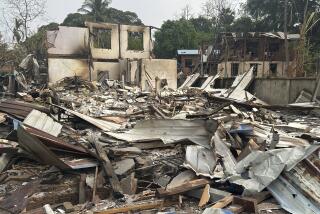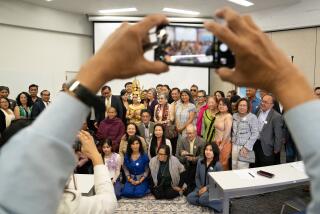Khmer Rouge Could Regain Power, U.S. Says
- Share via
WASHINGTON — The Khmer Rouge, the brutal force that once devastated Cambodia and killed more than 1 million people, currently has enough military strength to take over the country again if Vietnamese troops withdraw without a peace settlement, according to recent U.S. estimates.
The assessment, which underscores the serious dilemma inherent in U.S. efforts to persuade Vietnam to pull out of Cambodia, was contained in written answers filed last week by the State Department to questions from the Senate Foreign Relations Committee.
“To date, the only forces in the field in Cambodia that can stand up to the Khmer Rouge are Vietnamese regular army troops,” David Lambertson, deputy assistant secretary of state, wrote. “The (Cambodian government) troops are no match for those of the Khmer Rouge and have frequently been unable to hold positions turned over to them by the Vietnamese.
Government Would Fall
“Under current conditions, we do not believe that the (Cambodian government) could survive if Vietnam were to withdraw entirely its forces and assistance.”
Only last week, China announced that it will continue to ship weapons and supplies to the Khmer Rouge until after Vietnam withdraws from Cambodia.
The information submitted to Congress, apparently based on U.S. intelligence reports, went beyond past public statements by the Reagan Administration about the military strength of the Khmer Rouge.
Some U.S. officials privately expressed surprise that such an assessment had been made public. A State Department spokesman said that there had been no need to discuss the problem in public before but that, with Vietnam starting to withdraw its forces from Cambodia, “now there is the need for the estimate.”
According to U.S. estimates, the Khmer Rouge, a radical, agrarian-oriented Communist force, has 35,000 to 40,000 troops in Cambodia. The Vietnam-backed Cambodian government maintains 30,000 to 35,000 troops.
The United States is supporting two forces in the country--one loyal to Prince Norodom Sihanouk, which has a troop strength of 7,000 to 9,000, and another non-Communist resistance group that has 15,000 soldiers.
“It’s not a good equation,” remarked one U.S. official. “The Khmer Rouge has arms, money and willing fighters. And the reality is that the Chinese control the spigot (of arms supplies), because the United States hasn’t played in this (Cambodian) arena.”
The United States has given small amounts of non-lethal supplies to the two non-Communist resistance groups, but even this aid is said to be channeled through Chinese intermediaries. China has given some supplies and public support to the two non-Communist groups while serving as the principal supplier for the Khmer Rouge.
Split With Vietnamese
The Khmer Rouge originally was allied with Vietnamese Communist forces in campaigns against France and the United States in Indochina. But the group split off from the Vietnamese and, with the backing of China, steered its own course.
In 1975, after the fall of the U.S.-backed Lon Nol government in Cambodia, the Khmer Rouge, led by Pol Pot, took control. Over the next three years, the Khmer Rouge forced millions of people into the countryside, undertook a series of purges that left 1 million to 2 million people dead and brought the country to the brink of mass starvation.
At the beginning of 1979, Vietnam invaded Cambodia, toppled the Khmer Rouge from power and installed a new government, headed by Heng Samrin. China then invaded Vietnam in retaliation but was quickly forced to withdraw after suffering heavy casualties.
In recent months, U.S. officials, including Secretary of State George P. Shultz, have said repeatedly that they are opposed to having the Khmer Rouge return to power in Cambodia. But their statements have appeared to leave the door open for the Khmer Rouge to share power with other groups, so long as Pol Pot and other leaders from the previous regime are not part of the new coalition.
When China announced last week that it would continue sending supplies to the Khmer Rouge, a State Department spokesman declined to offer any objections to the decision. One policy-maker said that U.S. officials were disappointed by China’s action, but added: “You can’t bludgeon China into anything. China is too damn big.”
Peace Plan
On Tuesday, the Khmer Rouge’s clandestine radio station in Indochina broadcast a peace plan endorsed by Khmer Rouge leader Khieu Samphan that called for the breakup of the Cambodian resistance and that said the Khmer Rouge should not return to power by itself.
“Prince Sihanouk (who ruled Cambodia in the 1960s) couldn’t wipe out the Khmer Rouge,” observed one U.S. official. “Lon Nol tried, with the backing of the United States, and he couldn’t do it. Now the Vietnamese have tried for almost 10 years, and they haven’t been able to either.”
More to Read
Sign up for Essential California
The most important California stories and recommendations in your inbox every morning.
You may occasionally receive promotional content from the Los Angeles Times.










